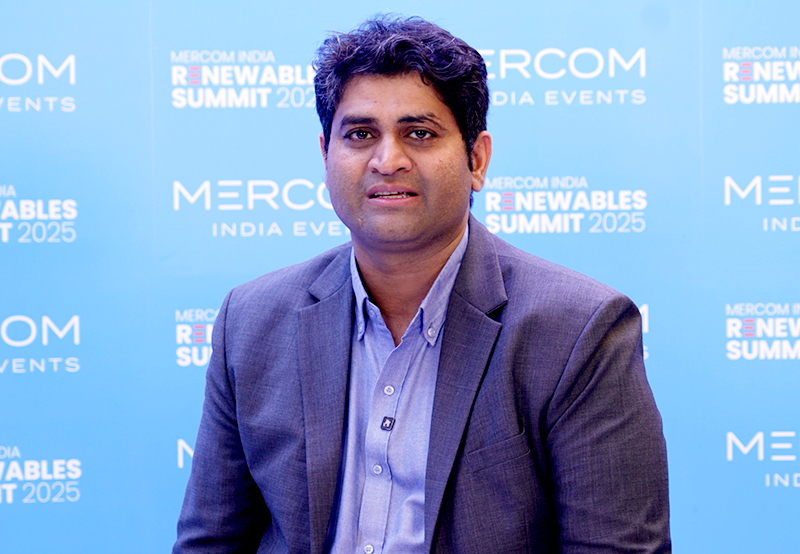Complex Land Laws and Skill Gaps Hinder Net Zero Progress: Interview
C&I consumers are opting for renewables as power tariffs in India are distorted
Follow Mercom India on WhatsApp for exclusive updates on clean energy news and insights
In an interview on the sidelines of the Mercom India Renewables Summit 2025, held in New Delhi on July 24 and 25, 2025, Rounak Muthiyan, Founder and Director of Kalpa Power, discussed how Kalpa Power covers the full energy spectrum from on-site solar and infrastructure management to open access parks and ESG-focused services.
He outlined Kalpa Power’s roadmap to commission 200 MW in the short term and achieve a goal of 5 GW within three years. Muthiyan also shared Kalpa’s plans to expand into hybrid renewables, battery storage, and integrated infrastructure solutions to meet India’s growing energy needs.
Could you shed some light on the services Kalpa Power provides?
At Kalpa Power, we call ourselves an Energy Management Company, not an EPC. That distinction matters. We aim to stand in the customer’s shoes and take a holistic view of their energy needs. We start with demand-side energy management, followed by on-premise solar installations. These can be net-metered, rooftop, or ground-mounted systems. We’ve solarized everything from car parks to storage yards.
Beyond the customer’s premises, we cater to open access solar needs. We currently operate across 12 solar parks, with four commissioned and eight more in the pipeline over the next 18 months. We also handle the entire transmission and infrastructure setup, including substations and high-voltage lines.
Two areas set us apart. One is our asset management service, which we refer to as a “bumper-to-bumper” model. We take full responsibility for the plant’s generation from the day it is commissioned until the end of its lifecycle. Our philosophy is to work for kilowatt-hours, not just kilowatts, to focus on performance, not just installation.
Second, we help clients map their carbon footprint and build tailored ESG and SDG roadmaps. While many talk about net zero, few know how to get there. We guide them with data and actionable steps.
What are the key drivers behind the shift of C&I consumers in India to green power?
The drivers are consistent with what they were when we began our journey. Our focus is on making power reliable, affordable, and environmentally friendly.
Green power brings reliability, especially compared to the grid, which can often be unreliable or unavailable. Even though renewables are intermittent, you have visibility into what you’re generating. The cost is a significant factor, too. Power tariffs in India are distorted due to cross-subsidies and pricing inefficiencies, making electricity expensive for industries. If India wants to be self-reliant and support manufacturing growth, affordable power is non-negotiable.
Environmentally, the shift to clean energy is no longer a choice but a necessity. We believe the transformation from availability-based power to dependable renewable energy is the next essential phase. For us, net zero is no longer just a mantra; it’s a way of life.
What are the major hurdles the industry must address to achieve net-zero goals?
The biggest challenge, I believe, is mindset. We are not making consumer products in a factory-controlled environment. We are executing projects, each with unique conditions and challenges.
Issues such as land acquisition, transformer availability, and right-of-way access are always present. But one challenge we don’t talk about enough is the shortage of skilled labor. We aspire to install gigawatts of renewable energy annually, but do we have the human resources to actually deliver this, from cell and module manufacturing to plant installation and commissioning?
Bounded problems, like equipment delays or transformer shortages, are bilateral and can be negotiated. Unbounded problems, like land-related issues, are far more complex. In India, land laws vary drastically across states. As someone said during the event, it often feels like operating in 29 different countries within India.
At Kalpa, we handle these challenges with a human-centric approach. We ensure that communities benefit from our projects through local employment, skill-building centers, and even agricultural development. This inclusive model has helped us scale quickly over the last two years.
What is Kalpa Power’s near- and medium-term roadmap?
We prefer to let our work speak before our commitments. However, in the short term, we plan to commission 200 MW of capacity in the next six months. In the medium term, we are seeing more customers understand the importance of transitioning from availability-based renewable power to dependable, performance-driven power supply. Based on our current momentum, we see a clear growth path toward reaching five gigawatts over the next three years.
We are also moving toward hybridized energy solutions, combining solar with wind wherever policy supports it. Battery storage is another major focus for us. Given the nature of energy demand and system balancing, storage should grow at a rate three times higher than renewables. We are actively investing in this space through capital, knowledge, and people. We believe energy storage is the next growth frontier, not just for Kalpa Power, but for the entire clean energy industry.
(Note: Sections of the interview have been paraphrased for better reading. Check out the video for a full chat)
